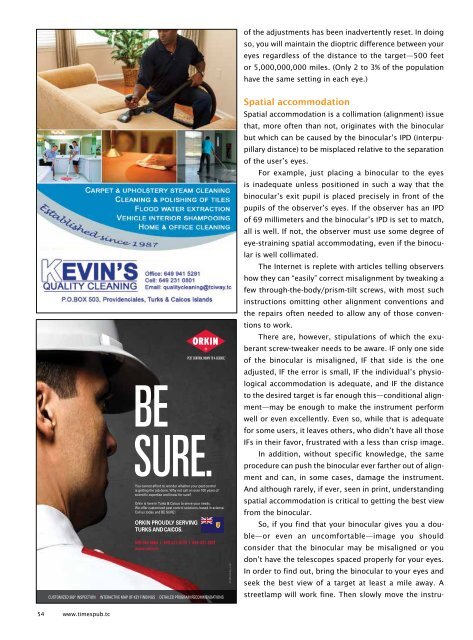Times of the Islands Winter 2019/20
Presents the "soul of the Turks & Caicos Islands" with in-depth features about local people, culture, history, environment, businesses, resorts, restaurants and activities.
Presents the "soul of the Turks & Caicos Islands" with in-depth features about local people, culture, history, environment, businesses, resorts, restaurants and activities.
You also want an ePaper? Increase the reach of your titles
YUMPU automatically turns print PDFs into web optimized ePapers that Google loves.
<strong>Times</strong> Kevin_<strong>Times</strong> Kevin 9/18/18 10:51 AM Page 1<br />
<strong>of</strong> <strong>the</strong> adjustments has been inadvertently reset. In doing<br />
so, you will maintain <strong>the</strong> dioptric difference between your<br />
eyes regardless <strong>of</strong> <strong>the</strong> distance to <strong>the</strong> target—500 feet<br />
or 5,000,000,000 miles. (Only 2 to 3% <strong>of</strong> <strong>the</strong> population<br />
have <strong>the</strong> same setting in each eye.)<br />
Spatial accommodation<br />
Spatial accommodation is a collimation (alignment) issue<br />
that, more <strong>of</strong>ten than not, originates with <strong>the</strong> binocular<br />
but which can be caused by <strong>the</strong> binocular’s IPD (interpupillary<br />
distance) to be misplaced relative to <strong>the</strong> separation<br />
<strong>of</strong> <strong>the</strong> user’s eyes.<br />
For example, just placing a binocular to <strong>the</strong> eyes<br />
is inadequate unless positioned in such a way that <strong>the</strong><br />
binocular’s exit pupil is placed precisely in front <strong>of</strong> <strong>the</strong><br />
pupils <strong>of</strong> <strong>the</strong> observer’s eyes. If <strong>the</strong> observer has an IPD<br />
<strong>of</strong> 69 millimeters and <strong>the</strong> binocular’s IPD is set to match,<br />
all is well. If not, <strong>the</strong> observer must use some degree <strong>of</strong><br />
eye-straining spatial accommodating, even if <strong>the</strong> binocular<br />
is well collimated.<br />
The Internet is replete with articles telling observers<br />
how <strong>the</strong>y can “easily” correct misalignment by tweaking a<br />
few through-<strong>the</strong>-body/prism-tilt screws, with most such<br />
instructions omitting o<strong>the</strong>r alignment conventions and<br />
<strong>the</strong> repairs <strong>of</strong>ten needed to allow any <strong>of</strong> those conventions<br />
to work.<br />
There are, however, stipulations <strong>of</strong> which <strong>the</strong> exuberant<br />
screw-tweaker needs to be aware. IF only one side<br />
<strong>of</strong> <strong>the</strong> binocular is misaligned, IF that side is <strong>the</strong> one<br />
adjusted, IF <strong>the</strong> error is small, IF <strong>the</strong> individual’s physiological<br />
accommodation is adequate, and IF <strong>the</strong> distance<br />
to <strong>the</strong> desired target is far enough this—conditional alignment—may<br />
be enough to make <strong>the</strong> instrument perform<br />
well or even excellently. Even so, while that is adequate<br />
for some users, it leaves o<strong>the</strong>rs, who didn’t have all those<br />
IFs in <strong>the</strong>ir favor, frustrated with a less than crisp image.<br />
In addition, without specific knowledge, <strong>the</strong> same<br />
procedure can push <strong>the</strong> binocular ever far<strong>the</strong>r out <strong>of</strong> alignment<br />
and can, in some cases, damage <strong>the</strong> instrument.<br />
And although rarely, if ever, seen in print, understanding<br />
spatial accommodation is critical to getting <strong>the</strong> best view<br />
from <strong>the</strong> binocular.<br />
So, if you find that your binocular gives you a double—or<br />
even an uncomfortable—image you should<br />
consider that <strong>the</strong> binocular may be misaligned or you<br />
don’t have <strong>the</strong> telescopes spaced properly for your eyes.<br />
In order to find out, bring <strong>the</strong> binocular to your eyes and<br />
seek <strong>the</strong> best view <strong>of</strong> a target at least a mile away. A<br />
streetlamp will work fine. Then slowly move <strong>the</strong> instru-<br />
54 www.timespub.tc

















